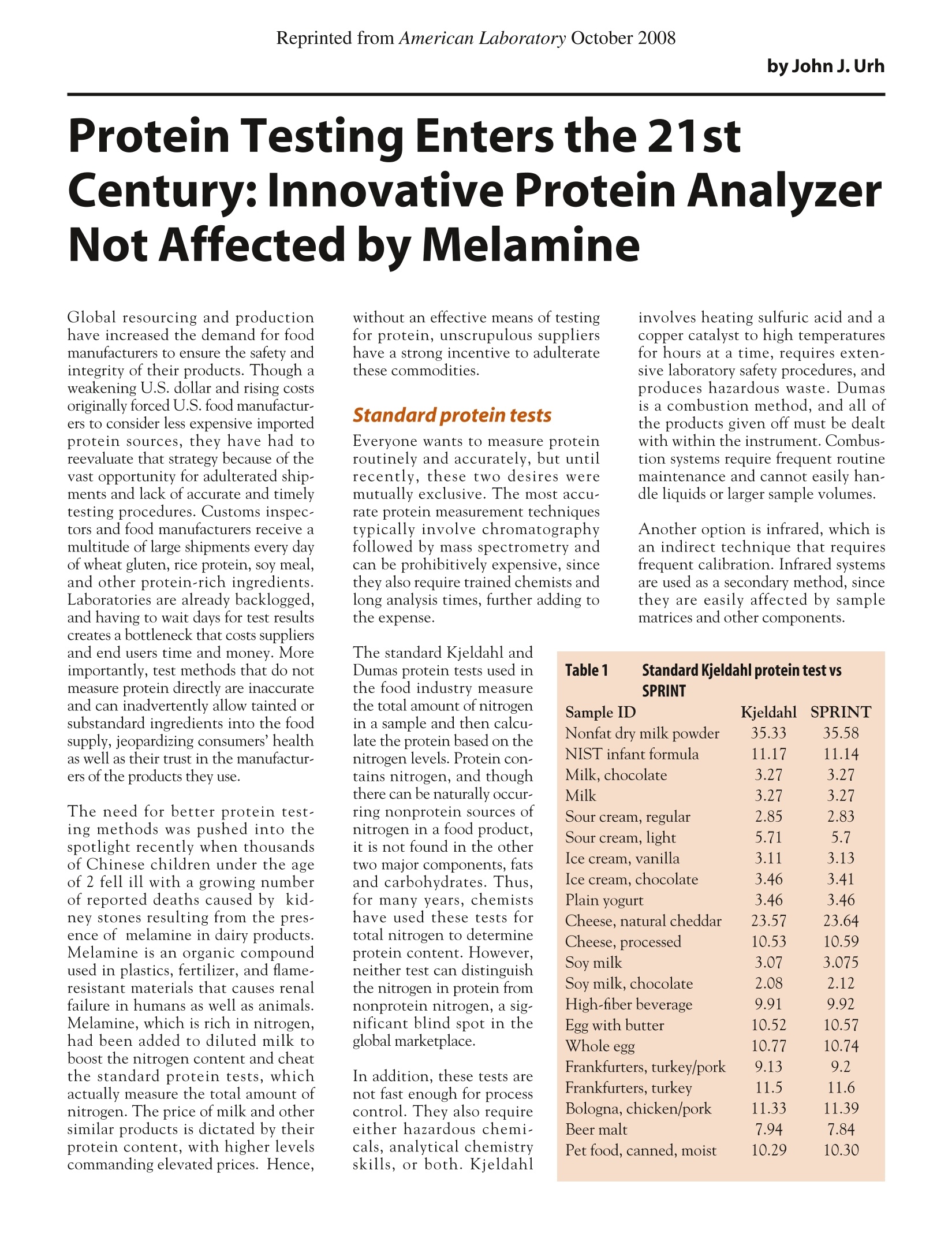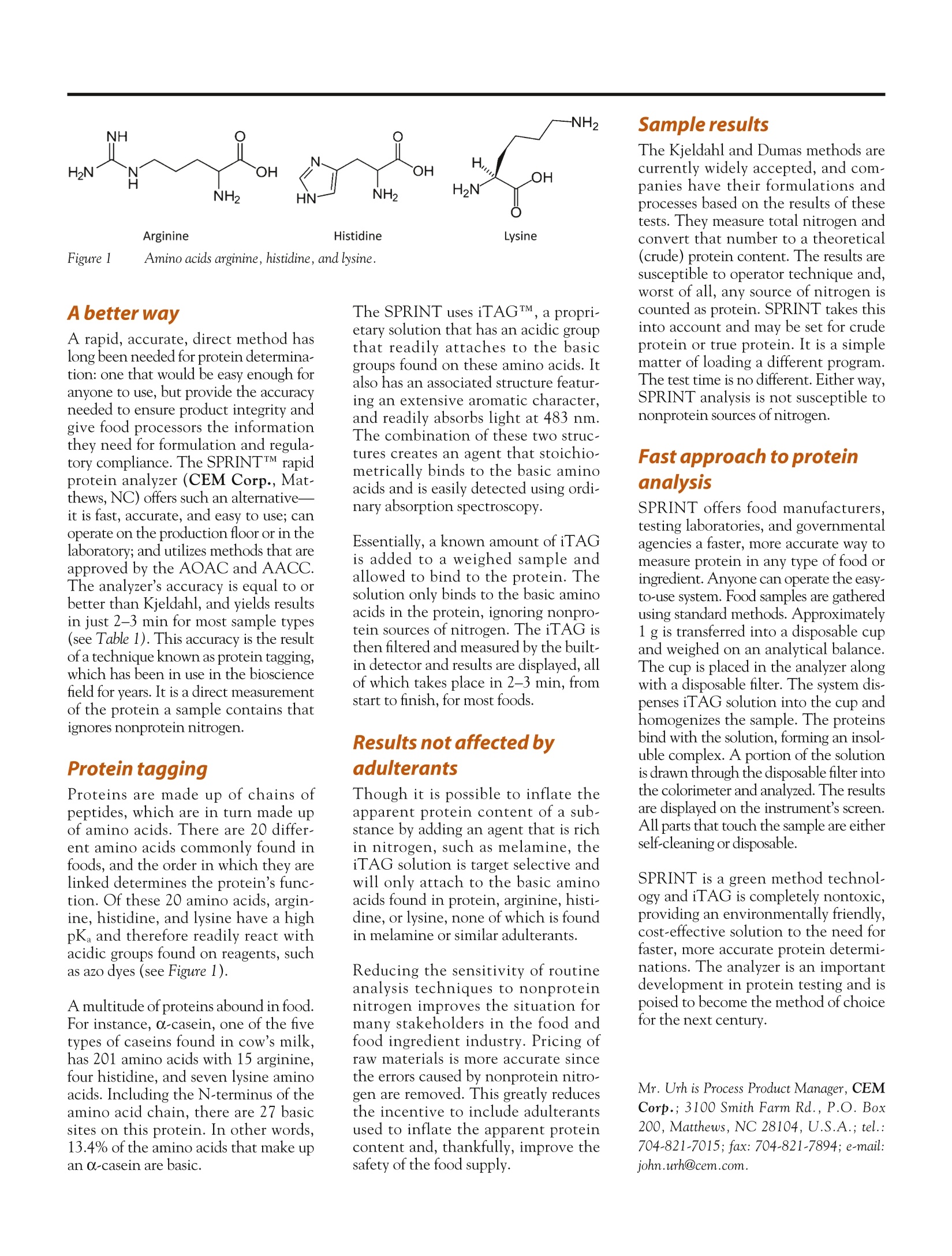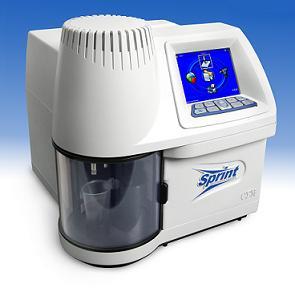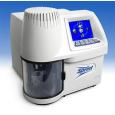方案详情
文
Global resourcing and productionhave increased the demand for foodmanufacturers to ensure the safety andintegrity of their products. Though aweakening U.S. dollar and rising costsoriginally forced U.S. food manufactur-ers to consider less expensive importedprotein sources, they have had toreevaluate that strategy because of thevast opportunity for adulterated ship-ments and lack of accurate and timelytesting procedures. Customs inspec-tors and food manufacturers receive amultitude of large shipments every dayof wheat gluten, rice protein, soy meal,and other protein-rich ingredients.Laboratories are already backlogged,and having to wait days for test resultscreates a bottleneck that costs suppliersand end users time and money. Moreimportantly, test methods that do notmeasure protein directly are inaccurateand can inadvertently allow tainted orsubstandard ingredients into the foodsupply, jeopardizing consumers!ˉ healtas well as their trust in the manufactur-ers of the products they use
方案详情

Reprinted from American Laboratory October 2008by John J. Urh Protein Testing Enters the 21stCentury:Innovative Protein AnalyzerNot Affected by Melamine Global resourcing and productionhave increased the demand for foodmanufacturers to ensure the safety andintegrity of their products. Though aweakening U.S. dollar and rising costsoriginally forced U.S. food manufactur-ers to consider less expensive importedprotein sources, they have had toreevaluate that strategy because of thevast opportunity for adulterated ship-ments and lack of accurate and timelytesting procedures. Customs inspectors and food manufacturers receive amultitude of large shipments every dayof wheat gluten, rice protein, soy meal,and other protein-rich ingredients.Laboratories are already backlogged,and having to wait days for test resultscreates a bottleneck that costs suppliersand end users time and money. Moreimportantly,test methods that do notmeasure protein directly are inaccurateand can inadvertently allow tainted orsubstandard ingredients into the foodsupply, jeopardizing consumers'healthas well as their trust in the manufactur-ers of the products they use. The need for better protein test-ing methods was pushed into thespotlight recently when thousandsof Chinese children under the ageof 2 fell ill with a growing numberof reported deaths caused by kid-ney stones resulting from the pres-ence of melamine in dairy products.Melamine is an organic compoundused in plastics, fertilizer,and flame-resistant materials that causes renalfailure in humans as well as animals.Melamine, which is rich in nitrogen,had been added to diluted milk toboost the nitrogen content and cheatthe standard protein tests, whichactually measure the total amount ofnitrogen. The price of milk and othersimilar products is dictated by theirprotein content, with higher levelscommanding elevated prices. Hence, without an effective means of testingfor protein, unscrupulous suppliershave a strong incentive to adulteratethese commodities. Standard protein tests Everyone wants to measure proteinroutinely and accurately, but untilrecently, these two desires weremutually exclusive. The most accu-rate protein measurement techniquestypically involve chromatographyfollowed by mass spectrometry andcan be prohibitively expensive, sincethey also require trained chemists andlong analysis times, further adding tothe expense. involves heating sulfuric acid and acopper catalyst to high temperaturesfor hours at a time, requires exten-sive laboratory safety procedures, andproduces hazardous waste. Dumasis a combustion method, and all ofthe products given off must be dealtwith within the instrument. Combus-tion systems require frequent routinemaintenance and cannot easily han-dle liquids or larger sample volumes. Another option is infrared, which isan indirect technique that requiresfrequent calibration. Infrared systemsare used as a secondary method, sincethey are easily affected by samplematrices and other components. The standard Kjeldahl andDumas protein tests used inthe food industry measurethe total amount of nitrogenin a sample and then calcu-late the protein based on thenitrogen levels. Protein con-tains nitrogen, and thoughthere can be naturally occur-ring nonprotein sources ofnitrogen in a food product,it is not found in the othertwo major components, fatsand carbohydrates. Thus,for many years, chemistshave used these tests fortotal nitrogen to determineprotein content. However,neither test can distinguishthe nitrogen in protein fromnonprotein nitrogen, a significant blind spot in theglobal marketplace. In addition, these tests arenot fast enough for processcontrol. They also requireeither hazardous chemi-cals, analytical chemistryskills, or both. Kjeldahl Sample ID Kjeldahl SPRINT Nonfat dry milk powder 35.33 35.58 NIST infant formula 11.17 11.14 Milk, chocolate 3.27 3.27 Milk 3.27 3.27 Sour cream, regular 2.85 2.83 Sour cream, light 5.71 5.7 Ice cream, vanilla 3.11 3.13 Ice cream, chocolate 3.46 3.41 Plain yogurt 3.46 3.46 Cheese, natural cheddar 23.57 23.64 Cheese, processed 10.53 10.59 Soy milk 3.07 3.075 Soy milk, chocolate 2.08 2.12 High-fiber beverage 9.91 9.92 Egg with butter 10.52 10.57 Whole egg 10.77 10.74 Frankfurters, turkey/pork 9.13 9.2 Frankfurters, turkey 11.5 11.6 Bologna,chicken/pork 11.33 11.39 Beer malt 7.94 7.84 Pet food, canned, moist 10.29 10.30 Figure 1 Amino acids arginine, histidine, and lysine. A better way A rapid, accurate, direct method haslong been needed for protein determina-tion: one that would be easy enough foranyone to use, but provide the accuracyneeded to ensure product integrity andgive food processors the informationthey need for formulation and regula-tory compliance. The SPRINTTM rapidprotein analyzer (CEM Corp., Mat-thews,NC) offers such an alternative-it is fast, accurate, and easy to use; canoperate on the production floor or in thelaboratory; and utilizes methods that areapproved by the AOAC and AACC.The analyzers accuracy is equal to orbetter than Kjeldahl, and yields resultsin just 2-3 min for most sample types(see Table 1). This accuracy is the resultof a technique known as protein tagging,which has been in use in the biosciencefield for years. It is a direct measurementof the protein a sample contains thatignores nonprotein nitrogen. Protein tagging Proteins are made up of chains ofpeptides, which are in turn made upof amino acids. There are 20 differ-ent amino acids commonly found infoods, and the order in which they arelinked determines the protein’s func-tion. Of these 20 amino acids, argin-ine, histidine, and lysine have a highpKa and therefore readily react withacidic groups found on reagents, suchas azo dyes (see Figure 1). A multitude of proteins abound in food.For instance, a-casein, one of the fivetypes of caseins found in cow's milk,has 201 amino acids with 15 arginine,four histidine, and seven lysine aminoacids. Including the N-terminus of theamino acid chain, there are 27 basicsites on this protein. In other words,13.4% of the amino acids that make upan a-casein are basic. The SPRINT uses iTAGTM, a propri-etary solution that has an acidic groupthat readily attaches to the basicgroups found on these amino acids. Italso has an associated structure featur-ing an extensive aromatic character,and readily absorbs light at 483 nm.The combination of these two struc-tures creates an agent that stoichio-metrically binds to the basic aminoacids and is easily detected using ordi-nary absorption spectroscopy. Essentially, a known amount of iTAGis added to a weighed sample andallowed to bind to the protein. Thesolution only binds to the basic aminoacids in the protein, ignoring nonprotein sources of nitrogen. The iTAG isthen filtered and measured by the built-in detector and results are displayed, allof which takes place in 2-3 min, fromstart to finish, for most foods. Results not affected byadulterants Though it is possible to inflate theapparent protein content of a sub-stance by adding an agent that is richin nitrogen, such as melamine, theiTAG solution is target selective andwill only attach to the basic aminoacids found in protein, arginine, histidine, or lysine, none of which is foundin melamine or similar adulterants. Reducing the sensitivity of routineanalysis techniques to nonproteinnitrogen improves the situation formany stakeholders in the food andfood ingredient industry. Pricing ofraw materials is more accurate sincethe errors caused by nonprotein nitro-gen are removed. This greatly reducesthe incentive to include adulterantsused to inflate the apparent proteincontent and, thankfully, improve thesafety of the food supply. Sample results The Kjeldahl and Dumas methods arecurrently widely accepted, and com-panies have their formulations andprocesses based on the results of thesetests. They measure tota nitrogen andconvert that number to a theoretical(crude) protein content. The results aresusceptible to operator technique and,worst of all, any source of nitrogen iscounted as protein. SPRINT takes thisinto account and may be set for crudeprotein or true protein. It is a simplematter of loading a different program.The test time is no different. Either way,SPRINT analysis is not susceptible tononprotein sources of nitrogen. Fastapproach to proteinanalysis SPRINT offers food manufacturers,testing laboratories, and governmentalagencies a faster, more accurate way tomeasure protein in any type of food oringredient. Anyone can operate the easy-to-use system. Food samples are gatheredusing standard methods. Approximately1 g is transferred into a disposable cupand weighed on an analytical balance.The cup is placed in the analyzer alongwith a disposable filter. The system dis-penses iTAG solution into the cup andhomogenizes the sample. The proteinsbind with the solution, forming an insol-uble complex. A portion of the solutionis drawn through the disposable filter intothe colorimeter and analyzed. The resultsare displayed on the instrument's screen.All parts that touch the sample are eitherself-cleaning or disposable. SPRINT is a green method technology and iTAG is completely nontoxic,providing an environmentally friendly,cost-effective solution to the need forfaster, more accurate protein determi-nations. The analyzer is an importantdevelopment in protein testing and ispoised to become the method of choicefor the next century. ( Mr. U rh is Process Product Manager, CEMCorp.; 3100 S mith F arm R d., P.O. B ox200, M atthews, N C 28104, U. S .A.; tel.:704-821-7015; fax: 7 04-821-7894;e-mail: iohn.urh@cem.com. )
确定


还剩1页未读,是否继续阅读?
培安有限公司为您提供《蛋白质中主要成分含量检测方案(蛋白测定仪)》,该方案主要用于其他中主要成分含量检测,参考标准--,《蛋白质中主要成分含量检测方案(蛋白测定仪)》用到的仪器有CEM Sprint 生物标签真蛋白测试仪
相关方案
更多
该厂商其他方案
更多










